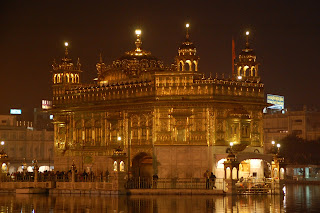
Punjab was the perfect follow-up to the chaos of Varanasi and probably the highlight of the trip to India. Amritsar is home to the Golden Temple, an especially sacred and beautiful Sikh place of worship. Sikhism is a religion I can get behind: it was created in reaction to the caste system and most temples offer a communal meal to anyone who's hungry. One problem though: carrying a dagger or spear is one of five duties Sikhs observe. No exceptions at the airport: there's a separate security procedure for Sikhs in Delhi and throughout Punjab.

Actually, speaking of airport security ... women get their own line here, which is a big deal in a country where women seldom leave the house. I whizzed through my empty queue and read for an hour and a half while Aaron battled with the men to get to our gate. Every passenger is given a once over with the detector wand, but for women this takes place in the privacy of a curtained cubicle. We should do this more often, no?
But I digress. The Golden Temple took my breath away.

It rivals my first impression of the Acropolis at night for best single view for the trip. To visit the temple we left our shoes in a locker and walked through holy water to clean our feet.

We both covered our heads (traditionally non-turbaned men don an orange kerchief do-rag-style - and this is how we both went). The temple is encircled by a pool of holy water, which people bath in and drink.


Inside the temple we saw the evening ceremony and received a halwa (lentil paste and honey - I like it more than Aaron). Most Sikh men wear do not cut their hair and their turbans cover a bun at the top of their head. There are many Sikh's in the Pacific Northwest, so this was a familiar tradition. Less so, were the giant turbans worn by some pilgrims, as well as the spears and other religious paraphanelia.

We ate lunch in the communal kitchen, which reportedly serves more than 20,000 people each day. The kitchen is staffed with volunteers and we saw circles of pilgrims peeling onions, washing dishes, and directing traffic. Thalis are served in a strict assembly line: get your plate, sit on a mat, then a line of servers pour dal, rice pudding, channa masala, water, and chipates onto your tray. Seconds are available and you can grab an orange for dessert on your way out. The whole process took less than ten minutes and was perfectly satisfying and clean.


Besides oggling the Glden Temple, our second objective was to visit India's only open border with Pakistan at Attari.

Though the border gate remains closed most of the time, every afternoon Pakistanis and Indians gather on their respective sides of the border to cheer and watch the gate open and close long enough for the guards on either side to raise a flag, march to face one another, stomp and show one another the bottoms of their feet, and then quickly shake hands.

We were in grandstands on the Indian side, where pop music was balsting, men and women were dancing (separately of course), and an MC was leading us in cheers for Hindustan! A similar scene was unfolding on the Pakistani side. Hilarious, bizarre, and totally fun stuff. Can you find ALow in the crowd?

xoxo Jessie
 Besides oggling the Glden Temple, our second objective was to visit India's only open border with Pakistan at Attari.
Besides oggling the Glden Temple, our second objective was to visit India's only open border with Pakistan at Attari. Besides oggling the Glden Temple, our second objective was to visit India's only open border with Pakistan at Attari.
Besides oggling the Glden Temple, our second objective was to visit India's only open border with Pakistan at Attari.